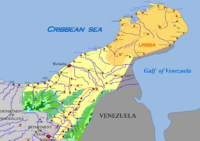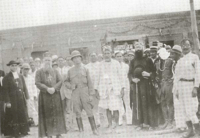Uribia, La Guajira
Uribia is town and municipality of the La Guajira department of Colombia. It is the youngest municipality of this Department since the year 2000. Northern Zone of the Cerrejón coal mines are located in this municipality. The municipality also contains the Serranía de Macuira mountain range which is an isolated low altitude mountain range in the middle of La Guajira Desert. One third of this mountain range is also a National Natural Park of Colombia.
Uribia | |
|---|---|
town | |
 Church in downtown Uribia. | |
.svg.png) Flag .svg.png) Seal | |
| Motto(s): Capital Indigena de Colombia (Indigenous capital of Colombia) | |
 Location of the town and municipality of Uribia in the Department of La Guajira. | |
| Country | Colombia |
| Region | Caribbean |
| Department | La Guajira |
| Foundation | March 1, 1935 |
| Government | |
| • Mayor | Cielo Redondo Mindiola (L)[1] |
| Area | |
| • Total | 8,200 km2 (3,200 sq mi) |
| Population (2019 est.[2]) | |
| • Total | 198,890 |
| • Density | 24/km2 (63/sq mi) |
| Time zone | UTC-5 |
| Website | www.municipiodeuribia.gov.co/ |
| * | |
Geography and climate

The Municipality of Uribia covers most of the northern area of the Guajira Peninsula, the northernmost part of South America. Uribia borders to the north and west with the Caribbean Sea which surround more than half the municipality; to the east Uribia has a short border with the Bolivarian Republic of Venezuela; to the south its borders the municipality of Maicao and southwest the municipality of Riohacha.
The Upper Guajira is arid, presenting clay formations with scarce vegetation of cactus and other xerophiles. The Serranía de Macuira lies in the middle of the upper region presenting three predominant hills 650 metres (2,130 ft) or more above sea level in the Macuira, Jarará and La Teta.[3]
Uribia has an arid climate (Köppen BWh) owing to its extremely hot temperatures that average around 30 °C (86 °F) on most days of the year. Rainfall averages around 360 millimetres (14 in) per year but even in the “wet” months of May, September, October and November it does not reach the level of potential evaporation. Humidity is generally high enough to make the consistent heat very uncomfortable.
| Climate data for Uribia | |||||||||||||
|---|---|---|---|---|---|---|---|---|---|---|---|---|---|
| Month | Jan | Feb | Mar | Apr | May | Jun | Jul | Aug | Sep | Oct | Nov | Dec | Year |
| Average high °C (°F) | 32.4 (90.3) |
32.8 (91.0) |
33.4 (92.1) |
33.9 (93.0) |
34.6 (94.3) |
34.8 (94.6) |
35.6 (96.1) |
35.0 (95.0) |
34.6 (94.3) |
33.4 (92.1) |
32.8 (91.0) |
32.6 (90.7) |
33.83 (92.89) |
| Average low °C (°F) | 23.4 (74.1) |
23.6 (74.5) |
23.9 (75.0) |
24.4 (75.9) |
25.2 (77.4) |
25.7 (78.3) |
25.6 (78.1) |
25.5 (77.9) |
25.1 (77.2) |
24.7 (76.5) |
24.4 (75.9) |
23.8 (74.8) |
24.61 (76.30) |
| Average rainfall mm (inches) | 2 (0.1) |
1 (0.0) |
11 (0.4) |
15 (0.6) |
51 (2.0) |
26 (1.0) |
5 (0.2) |
21 (0.8) |
51 (2.0) |
105 (4.1) |
59 (2.3) |
14 (0.6) |
361 (14.1) |
| Average relative humidity (%) | 59 | 58 | 56 | 58 | 61 | 60 | 54 | 56 | 61 | 70 | 71 | 64 | 61 |
| Source: Levoyageur[4] | |||||||||||||
History
Evangelization
The process of evangelizations of the Wayuu people restarted in 1887 with the return of the Capuchin friars under reverend friar José María de Valdeviejas. In 1905, Pope Pius X created the Vicariate of La Guajira and as first Vicar, friar Atanasio Vicente Soler y Royo in an attempt to "civilize" the Wayuu people.[5]
The friars the created the orphanages for Wayuu children beginning with the La Sierrita orphanage built in the Sierra Nevada de Santa Marta mountains in 1903; followed by the San Antonio orphanage in 1910 located by the Calancala River, Nazareth orphanage in the Serrania de Macuira mountains in 1913 creating a direct influence over the Rancherías of Guarrachal, El Pájaro, Carazúa, Guaraguao, Murumana, Garra patamana and Karraipía. While Nazareth had some control over the rancherías of Taroa, Maguaipa, Guaseipá and Alpanapause. The friars constantly visited the settlements inviting to attend mass. Wayuu children in the orphanage were educated with traditional European customs. Conflicts between the Wayuu people and the Colombian government decreased since then. In 1942 the village of Uribia celebrated for the first time Christmas and New Year's Eve.[5]
Official foundation

Uribia was founded officially on March 1, 1935 by Captain Eduardo Londoño Villegas in honor of Colombian Liberal Party leader Rafael Uribe Uribe, prior to this the village was named Chitki in Wayuu language. The main plaza was created and named after Francisco de Paula Santander one of the leaders of the Colombian independence from Spain.[6]
Culture
Uribia is predominantly inhabited by indigenous peoples pertaining to the Wayuu ethnic group. Cultural activities are directly related to them. The town celebrates the "Festival of the Wayuu Culture" from May 31 to June 1 every year.[8]
Transportation
Gallery
 Puerto Estrella in the municipality of Uribia
Puerto Estrella in the municipality of Uribia Cerro La Teta, northern municipality of Uribia - Guajira Desert
Cerro La Teta, northern municipality of Uribia - Guajira Desert
References
- (in Spanish) Colombian Registry of the Civil State: 2007 election results
- "Estimaciones de Población 1985 - 2005 y Proyecciones de Población 2005 - 2020 Total Municipal por Área (estimate)". DANE. Retrieved 20 June 2019.
- (in Spanish) todacolombia.com: La Guajira
- Climate, weather, temperatures - City : URIBIA
- (in Spanish) Luis Angel Arango Library: The Capuchins mission and the Wayuu Culture
- (in Spanish) Luis Angel Arango Library: Foundation of Uribia
- (in Spanish) Revista Credencial Historia. (Bogotá - Colombia). Edition 141 of September, 2001: Foundation of Colombian cities and towns
- (in Spanish) National System for Cultural Information: Festival of the Wayuu Culture
External links
- (in Spanish) Gobernacion de La Guajira - Uribia
- (in Spanish) Luis Angel Arango Library: Guajira visual memory